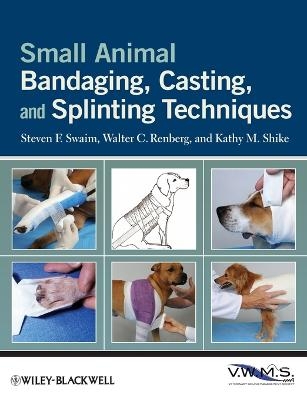
Small Animal Bandaging, Casting, and Splinting Techniques
Wiley-Blackwell (Verlag)
978-0-8138-1962-4 (ISBN)
Steven Swaim, DVM, is a professor emeritus at Auburn University. Walter Renberg, DVM, DACVS, is an associate professor at Kansas State University Kathy Shike, RVT, is a veterinary technician supervisor at Kansas State University.
Mission Statement xi
Foreword xiii
Preface xv
Acknowledgments xvii
Chapter 1 – Basics of Bandaging, Casting, and Splinting 3
Bandaging 3
Purposes and functions of a bandage 3
Components of a bandage 4
Primary-contact layer 4
Highly absorptive dressings 4
Gauze dressings 4
Hypertonic saline dressings 5
Calcium alginate dressings 5
Copolymer starch dressings 5
Moisture-retentive dressings 5
Polyurethane foam dressings 6
Polyurethane film dressings 6
Hydrogel dressings 7
Hydrocolloid dressings 7
Nonadherent semiocclusive dressings 7
Antimicrobial dressings 8
Extracellular matrix bioscaffold dressings 8
Secondary-intermediate layer 9
Tertiary-outer layer 9
Special considerations in bandaging, casting, and splinting 10
Frequency of changes 10
Security 10
Pressure relief 11
Joint immobilization 11
Maceration and excoriation 12
Need for sedation or anesthesia during bandage change 12
Casts and splints 13
General information 13
Purposes and functions of casts and splints 13
Materials 13
Splint rods 13
Commercial splints 13
Plastic splinting material 13
Stockinette 13
Casting tapes 14
Chapter 2 – Head and Ear Bandages 15
Emergency ear bandage 15
Indications 15
Technique 15
Aftercare 16
Advantages and complications 16
Basic head and ear bandage 16
Indications 16
Technique 16
Aftercare 22
Advantages and complications 23
Chapter 3 – Thoracic, Abdominal, and Pelvic Bandages 25
Thoracic, abdominal bandages 25
Circumferential thoracic, abdominal bandage 25
Indications 25
Technique 26
Aftercare 29
Advantages and complications 29
Windowed thoracic, abdominal bandage 29
Indications 29
Technique 29
Aftercare 29
Advantages and complications 29
Thoracic, abdominal tie-over bandage 29
Indications 29
Technique 30
Aftercare 31
Advantages and complications 31
Pelvic bandages 32
Circumferential pelvic bandage 32
Indications 32
Technique 33
Aftercare 35
Advantages and complications 35
Windowed pelvic bandage 36
Indications 36
Technique 36
Aftercare 38
Advantages and complications 38
Pelvic tie-over bandage 39
Indications 39
Technique 39
Aftercare 39
Advantages and complications 39
Pelvic extension splints 39
Indications 39
Technique 40
Aftercare 41
Advantages and complications 41
Chapter 4 – Extremity Bandages, Casts, and Splints 43
Tail bandages 43
Indications 43
Technique 44
Aftercare 47
Advantages and complications 47
Forelimb bandages, casts, and splints 47
Basic soft padded limb bandage 47
Indications 48
Technique 48
Aftercare 54
Bandage removal 54
Bandage replacement 55
Advantages and complications 55
Interdigital and interpad areas 55
Primary bandage layer 56
Secondary bandage layer 56
Tertiary bandage layer 56
Basic paw and distal limb bandage 56
Indications 56
Technique 56
Interdigital/interpad areas 56
Primary bandage layer, “donut” pads, and “stirrups” 58
Secondary bandage layer 62
Tertiary bandage layer 64
Aftercare 67
Bandage removal 67
Bandage replacement 67
Advantages and complications 68
Interdigital/interpad area 68
Primary bandage layer 68
Secondary bandage layer 68
Tertiary bandage layer 69
Paw pad pressure relief 69
Indications 69
Technique—moderate wounds on small to medium-sized dogs 69
Metacarpal/metatarsal pad 69
Digital pads 70
Aftercare—moderate wounds on small to medium-sized dogs 71
Advantages and complications—moderate wounds on small to medium-sized dogs 71
Techniques—major reconstructive or salvage paw surgery, especially on large dogs 71
”Clamshell” splints 71
One-half “clamshell” splint 72
Aftercare—major reconstructive or salvage paw surgery, especially on large dogs 73
Advantages and complications—major reconstructive or salvage paw surgery, especially on large dogs 73
Dorsal paw pressure relief 73
Indications 73
Technique 74
Aftercare 75
Advantages and complications 75
Carpal sling 75
Indications 75
Technique 76
Aftercare 78
Advantages and complications 78
Basic forelimb splint 78
Indications 78
Technique 78
Aftercare 83
Advantages and complications 83
Basic forelimb cast 83
Spica bandage and lateral splint 83
Indications 83
Technique 84
Aftercare 87
Advantages and complications 87
Aluminum rod loop elbow splint 88
Indications 88
Technique 88
Aftercare 89
Advantages and complications 89
Velpeau sling 89
Indications 89
Technique 89
Aftercare 92
Advantages and complications 92
Pelvic limb bandages, casts, and splints 92
Basic soft padded limb bandage 92
Basic pelvic limb splint 93
Basic pelvic limb cast 93
Indications 93
Technique 93
Aftercare 99
Advantages and complications 99
Ehmer sling 100
Indications 100
Technique 100
Aftercare 104
Advantages and complications 104
90/90 sling 104
Indications 104
Technique 105
Aftercare 108
Advantages and complications 108
Tie-over bandage 108
Indications 108
Technique 108
Aftercare 108
Advantages and complications 109
Chapter 5 – Restraint 111
Elizabethan collar 111
Plastic wrap-around collar 113
Towel collar 113
Muzzles 114
Side braces 114
Topical chemical deterrents 118
Electronic devices 119
Suggested Reading 121
Index 123
| Verlagsort | Hoboken |
|---|---|
| Sprache | englisch |
| Maße | 188 x 241 mm |
| Gewicht | 340 g |
| Themenwelt | Veterinärmedizin ► Klinische Fächer ► Chirurgie |
| Veterinärmedizin ► Kleintier | |
| ISBN-10 | 0-8138-1962-8 / 0813819628 |
| ISBN-13 | 978-0-8138-1962-4 / 9780813819624 |
| Zustand | Neuware |
| Informationen gemäß Produktsicherheitsverordnung (GPSR) | |
| Haben Sie eine Frage zum Produkt? |
aus dem Bereich


